The Great Wall of China is a northern Chinese barrier that stretches from the Jiayuguan Pass to the Hushan Mountains in Liaoning Province, and ends at Bohai Bay. The structure is known for its stunning appearance, which exemplifies the intelligence and diligence of the ancient Chinese people. The construction of the wall took place during the period of warring states and restoration took place by several dynasties afterwards. During the period of the warring state, the original goal of the Great Wall of China was to protect the kingdoms from Xiongnu attacks. Later, reconstruction took place on a larger scale during the Qin and Ming dynasties.
The Great Wall of China is the world's largest military fortification. It towers and meanders between mountain ranges, and the construction took place about 2,000 years ago. The various struggles, power struggles, several dynasties, and political and economic historical events that affected Imperial China for nearly 2,000 years contributed to its splendor.
The architectural significance of the structure derives from its components, including the wall, gates, villages, garrisons, signal towers and aesthetic features. It is also known for the many classical poems, folk literature, drama and the story of it written by monarchs, warriors, literati and remarkable poets. The Great Wall of China has a long and rich history, and there is much to learn about it.
History of the Great Wall of China
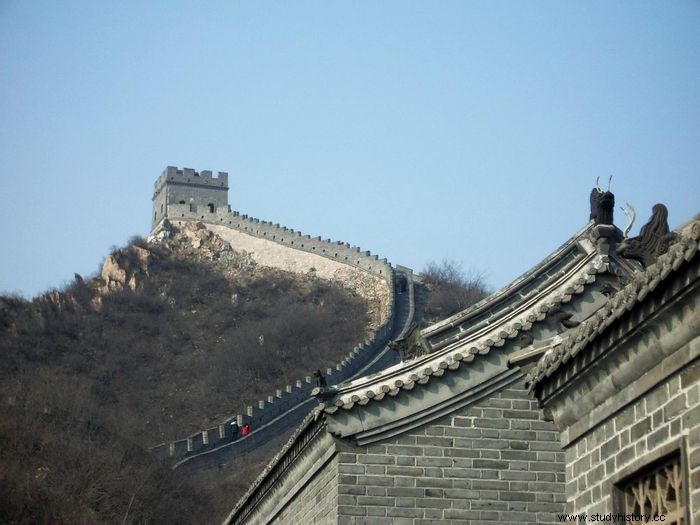
Xiongnu often attacked the states of Qi, Yan and Zhao from the north throughout the metaphase of the warring state, which lasted from the 5th century BCE to 221 BCE. Because the three states could not fight Xiongnu, they decided to build fortresses to protect themselves. The construction of the Great Wall of China was originally to withstand attacks with swords and spears. Furthermore, the construction of these barriers took place mostly by pounding soil and gravel.
Qin Shi Huang, an emperor of the Qin Dynasty, later defeated all the kingdoms and united China in 221 BCE To connect the old fortifications, he ordered the construction of a new wall. The building materials for the wall were stones and earth. However, only a few parts of the structure were erected before or during the Qin Dynasty still today. To defend against northern encroachment, the Han, Sui, North, and Jin dynasties constructed, strengthened, or expanded parts of the Great Wall of China.
The Ming Dynasty defeated the Manchurians and Mongols, and the dynasty was in grave danger. The emperor then gave instructions to build fortifications along the northern border. The Ming Dynasty used a combination of bricks and stones to construct their fortifications, making them stronger. As the Mongols continued to attack the region, they spent considerable resources repairing and strengthening the fortifications. Geographical data indicate that the areas around Beijing are particularly robust. Unfortunately, many parts of the Great Wall of China, including the Ming Wall, have disappeared due to years of wear and tear and artificial destruction. Although many parts of the structure have been rebuilt and preserved, there are still some remote and hard-to-reach parts that need maintenance.
The Early Wall (770 BC to 221 BC)
The eastern and central areas of China were divided into various small kingdoms or principalities during the spring and autumn period from 770 to 476 BC. and the period of the warring state from 475 to 221 BC. The princes ordered autonomous walls erected along state borders to protect their states. The first was created between the states of Lu and Qi around 650 BCE and later became part of the Chu State Wall.
The Great Wall of China during the Qin Dynasty (221 BC to 206 BC)
The conquest and consolidation of the other states took place by Qin Shihuang (king of the state of Qin from 247 to 221 BC). Emperor Qin Shihuang ordered that the northern parts of the state's border walls, especially those in northern China in the states of Qin, Zhao and Yan, have a connection to the first real Chinese wall. The structure should also have a coherent line of defense against Mongolian harassment from the north. In a united China, other state border barriers became outdated and corroded or torn.
The Great Wall of China during the Han Dynasty (206 BC to 204 AD)
Tensioning and strengthening of the northern defense took place, with parts of the structure running parallel for hundreds of miles and connecting along the inner Mongolian border. The Han Dynasty wall was more than 5,000 miles long and stretched from the North Korean coast at Pyongyang in the east to the Jade Gate Pass (Yumenguan) in the west. Many branch walls, natural obstacles and trenches made up the total length.
The Great Wall of China during the Yuan Dynasty (1271 to 1368 AD)
The Yuan Dynasty was the first dynasty in which a non-Han population, the Mongols, ruled over all of China. For 1,500 years, the Great Wall of China had preserved Han China. However, the construction of the structure ended during the Yuan Dynasty. This period coincided with the unification of China and Mongolia in the north.
The Great Wall of the Ming Dynasty (1368 to 1644 AD)
During the Ming Dynasty, China prospered, and its military prowess grew. The construction of the Great Wall of China took place gradually over 100 years to deter future northern invasions. The construction of the Ming Great Walls, which make up most of the existing Great Wall, took place during the Ming Dynasty. Even the construction of the Badaling and Mutianyu sections of the Great Wall of China near Beijing took place during the Ming Dynasty. Ming erected the structure, which had over 25,000 16 huge watchtowers ranging from 26 to 20 feet in height, 16 feet above the bottom and XNUMX feet above the top.
The Great Wall of China after the Ming Dynasty (1644 and beyond)
In 1644 AD. the Manchu armies broke the Great Wall of China at the Shanhai Pass, signaling the end of the Han Authority in China and the beginning of the Qing Dynasty (1644–1911 AD). It also marked the end of the building and the maintenance of the Great Wall of China until the Badaling section was repaired by the People's Republic of China and opened to the public as a tourist attraction in 1957 AD
The construction of the Great Wall of China
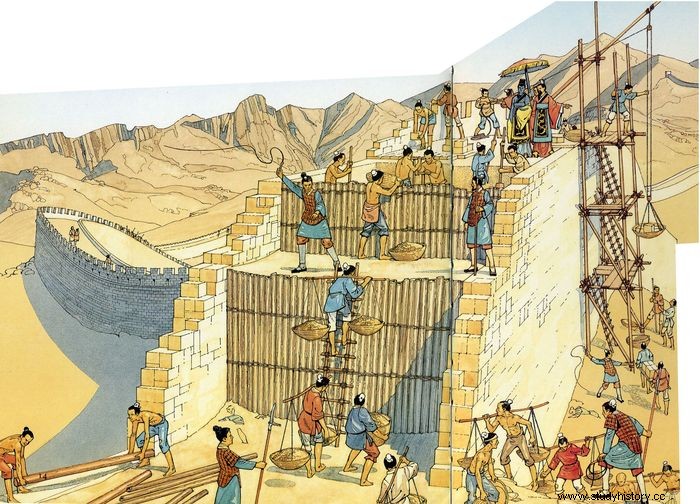
The construction of the structure was possible by using a massive force of troops, convicts and locals. The finished product shows the Chinese's knowledge and perseverance. In addition, the architectural style of the Great Wall of China is a masterpiece of world architectural history. Because swords and spears, lances and halberds, and bows and arrows were the only weapons available in antiquity, walls with passports, watchtowers, signal towers and moats became a key tactic.
After the Qin Dynasty, feudal rulers worked to improve the construction of the Great Wall of China to ensure the protection of the dynasties. Many people lost their lives by building the Great Wall of the Qin Dynasty. Tens of thousands of people, including conscripts, slaves, prisoners, and ordinary citizens, worked long, hard hours. As a result, the story of the Great Wall of China has frequent connections with the dictatorship of the first emperor of Qin.
During the Ming Dynasty, a comprehensive defense system was built with garrison towns, garrison stations, passages, log cabins, additional wall structures, watchtowers and beacon towers along the structure, each with its own status and role. The system allowed the Imperial Court to communicate with military and administrative institutions at all levels, including those at the local level, and provided border forces with the tools they needed to defend effectively.
The structure of the Great Wall of China
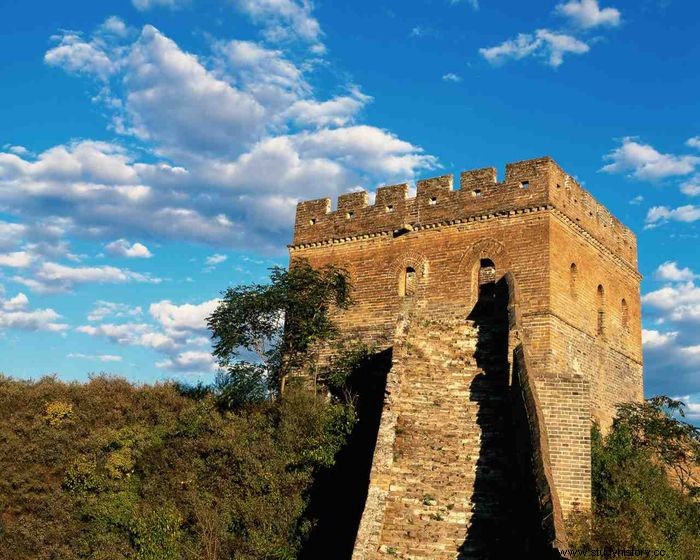
The Great Wall of China was more than a structure. It was an integrated military defense system with, among other things, surveillance towers, fortresses for command posts and logistics, and communications lighthouses.
The renovation of the Great Wall of China to become stronger and more complex took place because the improvisation of building techniques took place during the Ming Dynasty (1368–1644 AD).
- Wall body: Impact walls 6 feet high with loopholes and crenels and parapet walls 4 feet high were typical of the Ming Great Wall.
- Flanking tower: There were flanking towers every 1,640 feet or less along the Great Wall of China so that defenders could shoot arrows at invaders at the front of the structure.
- Fortress: Fortresses were erected at important / vulnerable access points (passports), such as Shanhai Pass Fortress, Juyong Pass Fortress and Jiayu Pass Fortress. The forts had several arched windows and gates. The gatehouse of the fortress was the most powerful and unassailable fortification of the Great Wall of China.
The Legend of the Crying Lady
After the construction of the Great Wall of China, many wonderful legends and stories emerged. These myths have since spread across the country. Several happened under the building.
Meng Jiangnu's story is the most famous and often circulated. The story took place during the Qin Dynasty (221 BCE-206 BCE). According to the story, Meng Jiangnu's intense sobbing caused part of the Great Wall of China to crumble. Federal officials arrested Meng Jiangnu's spouse, Fan Qiliang, and sent him to build the Great Wall of China. After hearing nothing from him since he left, Meng Jiangnu went out to find him. Unfortunately, by the time she arrived at the Great Wall of China, her husband had already passed away. She sobbed uncontrollably when she learned the terrible news. Part of the structure collapsed due to her crying. According to this story, the construction of the Great Wall of China took place using tens of thousands of Chinese farmers.
Beautiful murmurs and legends help preserve Chinese history and culture. Many different stories were developed and propagated throughout each dynasty after the construction of the Great Wall of China.
Some facts about the Great Wall of China
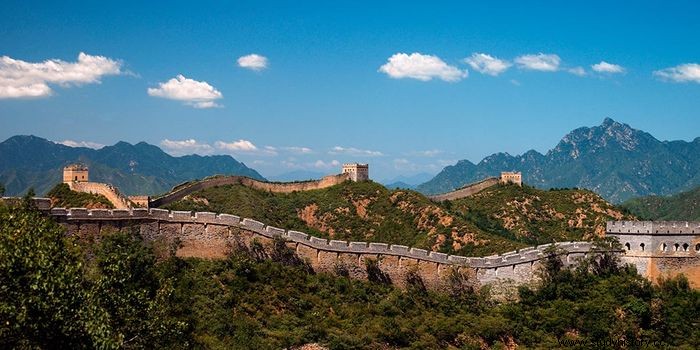
It is not a single structure
While the name Great Wall of China suggests that we are discussing a continuous wall of masonry, this is not the case. What appears to be a simple monument is a system of defense construction of many dynasties. Many of these barriers are actually parallel to each other. Also, not all of these fortifications are built of real walls. Even the inclusion of natural obstacles such as rivers and hills was part of the Great Wall of China.
Convicts were forced to work on the Great Wall from time to time
Over a million people, including civilians, prisoners of war, soldiers, and criminals, struggled with the structure. For crimes ranging from murder to tax fraud, convicts were forced to serve as workers, especially during the Qin and Han dynasties. Convicts would shave their heads and be forced to wear iron rings. In addition, they were responsible for keeping watch during the day and building at night.
The Great Wall of China is gradually disappearing
The Great Wall of China, which spans half the length of the equator, passes through 15 different places. Understandably, it would be challenging to maintain something so massive, and this has unfortunately been the case with the Great Wall of China. It is claimed that 30% of the Ming dynasty's construction has already disappeared, eaten away overtime after being abandoned and neglected. In fact, according to a 2014 analysis by the Great Wall of China Society, only 10% of the monument is in good condition, while 74% is in poor condition.
Unfortunately, the Great Wall of China has to contend with more than just the forces of nature. Humans also continue to cause harm. Sections of more rural sites have sometimes been demolished to make way for land development or deconstructed for building materials. In addition, beautiful bricks have a black market, and tourists have been known to steal these valuable items. However, nature conservation organizations are urging the government to increase protection and provide more education and grants to local people to counter the challenges.
The structure is not visible from space
A widespread misconception about the Great Wall of China is that it is possible to see it from space with the naked eye. It's easy to see how this story unfolded, given its enormous size, but that's not the case. According to NASA, urban history dates back to 1938. It only got stronger until the Apollo astronauts set foot on the moon. Actual astronauts have repeatedly said that this is not the case. Even from low ground, the Great Wall of China is not visible. The materials it was composed of are a factor that prevents it from being seen.
New sections are constantly being found
Given the age of the Great Wall of China, it may surprise you to discover that new portions are constantly being discovered. For example, new parts of the Ming Dynasty wall were discovered in 2009 using infrared rangefinders and GPS. Hills, pits and rivers had covered the 180 km long part of the structure.
Archaeologists discovered 60 kilometers of wall remains on the border of the Ningxia Hui Autonomous Region and Gansu Province in 2015, an area previously thought to be devoid of relics from the Great Wall of China. The ruins are said to date from the construction of the Qin Dynasty. Floods and natural erosion reduced the height of the nine pieces to between 3 and 16 feet in some places.
It is the world's longest man-made structure
At 13,171 5 miles, the Great Wall of China is the world's longest man-made structure. The Great Wall of China at Gorgan, erected in Iran in the 6th or 125th century and covering less than XNUMX miles, is the world's second longest man-made structure. As a result, it is reasonable to assume that the Great Wall of China will retain its title for a long time.
The Great Wall of China we see now is recent
Many ancient Chinese empires built the Great Wall of China between the 7th and 8th centuries BCE. During his reign in the 3rd century BCE, China's first emperor, Qin Shi Huang, began to unite these wall lengths. However, almost all of these early barriers have disappeared over time.
According to an official survey, the Ming Dynasty is responsible for 5,500 miles of the magnificent monument. This section contains 3,889 16 miles of physical structure, including some of the Great Wall of China's most popular tourist attractions. Badaling, Mutianyu and Jinshanling are three well-preserved parts of the Great Wall of China near Beijing that attract millions of visitors each year. Mings built on an earlier part of the structure in Mutianyu. But Badaling and Jinshanling were both built from scratch in the XNUMX century AD
Builders used rice to build the wall
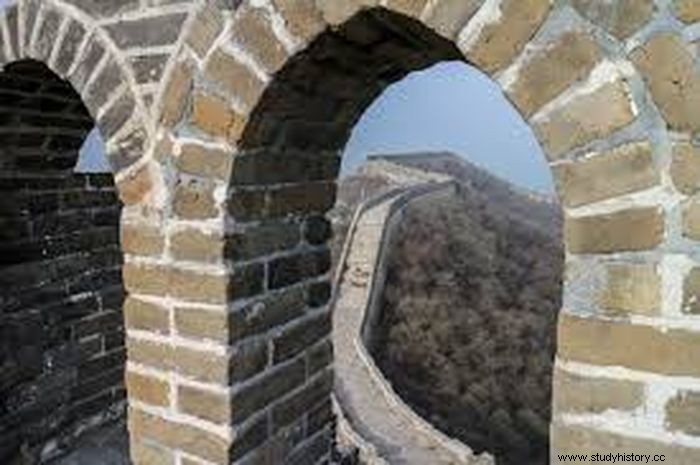
It goes without saying that sticky rice is sticky. This sticky risk characteristic was used by the builders of the Great Wall of China to make more durable fortifications. To make the mortar stronger, they added rice to the mixture. One of the explanations for the duration of the Great Wall of China is the presence of amylopectin in rice.
The old workers left their mark on the bricks
Some argue that the words on the bricks are a system established by General Qi Jiguang to assess the quality of the troops' bricks and clarify duties. Historians, however, question this belief as it was the workers instead.
It is the greatest cultural emblem of the Chinese people
The Great Wall of China is an engineering feat that took countless works over 2,000 years to complete. It also reflected the clashes and exchanges between agricultural cultures and nomadic cultures. The Juyong Pass served as an important commercial canal between Beijing and Inner Mongolia during the Yuan Dynasty (1272-1368 AD). In addition, because Yuan rulers traveled this road frequently, temporary imperial homes, temples, and gardens were built.
The conclusion
The Great Wall of China attracts millions of visitors each year as one of the most recognizable man-made structures on the planet. The massive fortresses are technical wonders that stretch across northern China. The project had two distinct goals; Firstly, the construction of the structure took place to protect Chinese lands from nomadic tribes, and secondly, it was used as a customs depot along the Silk Road to maintain order at the border. Although some planning and administration was there after the adoption of the order, the construction of the Great Wall of China took place at the whim, desire and order of the reigning emperor, without any consultation process for stakeholders.
